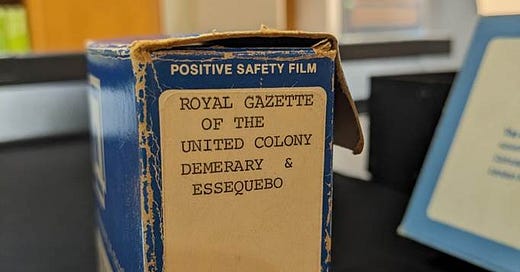Microfilm and microfiche are essential to archival storage and access. In the UK this method is used by libraries and archives to provide copies of many key documents to researchers. Such as parish registers, wills and newspapers. This helps preserve the originals and provides important back-ups. Modern digitisation projects often use microfilm/fiche as their source, rather than the original.
Microfiche is a small rectangular piece of plastic. Fiche is French for a slip of paper or index card. Capable of lasting a hundred years and in a tiny format, it stores printed information in a form too small to be read by the human eye. Documents are photographed and kept on transparent film, viewed through a microfiche reader. Microfilm comes on flat sheets of photographic film with a single sheet storing numerous images, again read by a microfiche reader. A microfiche reader consists of a light and a magnifying lens which projects the image onto a screen.
Box of microfilm, British Library
Using microfiche readers can be daunting for researchers coming to them for the first time. These machines are often large, usually old, and can appear quite alien. Not helped by the fact that models look and operate differently from each other. As a general rule there is a screen with which to view images and a set of reels and a glass plate to arrange the film/fiche on. Usually you pull this forwards to open up the plate, under which you can place the item you want to look at. For microfilm you push the reel sideways onto the holder and feed it under the glass plate onto a reel at the other end. There are different functions on the machines such as to rotate the image, change focus, zoom in and out and change brightness. All will have a forward and back function, usually a button and with slow and fast forward options. Modern readers may be connected to a computer where you can print or download an image onto a memory stick.
The key to using microfilm and microfiche is to let the archives or library staff show you how things are done there. Even if you have used them before elsewhere. Each institution will have a different set of processes when it comes to booking readers, accessing the films/fiche, how many you can call up at a time etc.. There are many different makes and models of machines with each one operating slightly differently. Staff will be showing people all the time so don’t be afraid to ask, and they will usually offer.
Microfilm/fiche have both disadvantages and advantages to bear in mind. As they are not original documents and being one step removed, have issues of inaccurate replication. There is a good chance that you will not be able to read everything, and some parts may have been missed. Also, over time films can themselves become damaged, especially as many are decades old and regularly used. Often a film will contain multiple documents so you have to search through for what you need and often your document will be split over multiple films. Sometimes the indexes, catalogues and even information on the cases of films themselves will be inaccurate.
This medium is however part and parcel of research and for many places this is the primary or indeed the only way to access certain document types. It is often quicker to search through microfilms compared to original documents which can be unwieldy and require care to work through.
Despite technological advances which are in some ways reducing the need for microfilm/fiche, primarily through digitisation, this system is still very much with us. Researchers will continue to use it for some time to come.
References and Resources:
The Strange History of Microfilm, Which Will Be With Us for Centuries - Atlas Obscura
The Ultimate Guide To Microfiche & Microfilm
A brief history of preservation: microfiche and microfilm | ESA Archives Portal
A. Nicoll, ‘The ‘‘Basic’’ Use of Microfilm’, PMLA 68, no. 4 (1953): 62–66






With the major Hollywood studios going back to the use of actual film for preservation copies of their catalog and music companies doing something similar with "vinyl" records over various forms of magnetic tape, materials like microfiche and microfilm may surprise us yet. (And I just this week heard about 'dvd' rot in which the compact discs used to record video and movies is also deteriorating.
For researchers working in small archives and historical centers it is important to know that the staff you meet (usually volunteers) might not know how to correctly operate micro film readers. That’s just one of the challenges of doing research.